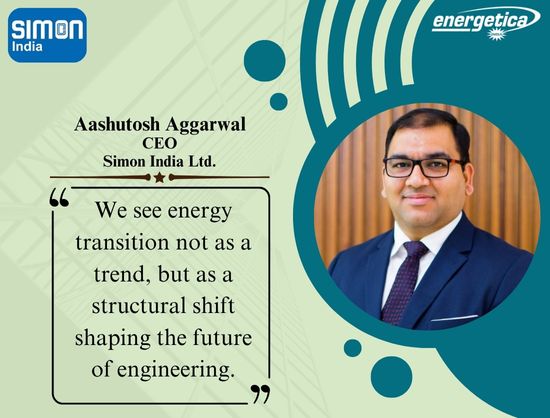Our Terms & Conditions | Our Privacy Policy
Aashutosh Aggarwal, CEO at Simon India Ltd.
August 04, 2025. By Abha Rustagi
At Simon India, we’ve aligned our capabilities to support decarbonisation, circularity, and climate resilience, said, Aashutosh Aggarwal, CEO, Simon India Ltd., in an interview with Abha Rustagi, Associate Editor, Energetica India.
Que: Simon India has recently introduced its ‘2.0’ transformation strategy. Could you elaborate on how this marks a shift from the company’s traditional engineering model to a more AI-integrated, future-facing organisation?
Ans: Simon India 2.0 is our strategic pivot toward becoming a next-generation engineering and EPC solutions provider. Traditionally rooted in process engineering excellence and EPC delivery, we are now embedding artificial intelligence, digital automation, and predictive analytics into the core of our operations.
This transformation is not just technological—it’s cultural and structural. We’ve introduced PROTON, our proprietary AI-powered project control tower, enabling real-time project visibility, risk detection, and performance optimisation.
Additionally, our digital engineering initiatives—like modular design systems, digital twins, and cloud-based collaboration tools—ensure faster execution, greater cost-efficiency, and enhanced stakeholder alignment. Simon India 2.0 represents our commitment to building intelligent, future-ready industrial ecosystems.
Que: In the current industrial landscape, where energy transition and sustainability are major themes, how is Simon India repositioning itself to align with these evolving priorities?
Ans: We see energy transition not as a trend, but as a structural shift shaping the future of engineering. At Simon India, we’ve aligned our capabilities to support decarbonisation, circularity, and climate resilience through dedicated service lines in green hydrogen, green ammonia, and ESG consulting.
Our engineering teams now integrate lifecycle-based design thinking, energy optimisation models, and environmental compliance frameworks from the earliest project stages. We are also building partnerships with climate-tech innovators and technology licensors to accelerate sustainability outcomes. This approach allows us to support our clients in meeting both regulatory requirements and long-term ESG ambitions.
Que: Simon 2.0 emphasises AI-powered predictive maintenance and operational intelligence. Which industries or client segments have shown the strongest interest or adoption of these solutions so far?
Ans: The strongest traction so far has come from the chemicals, fertilisers, and oil & gas sectors—particularly where operational uptime and asset longevity are critical. Clients managing complex utility systems, batch processing, or continuous flow plants have been early adopters of our predictive analytics and AI-driven maintenance solutions.
We are also seeing rising interest from emerging sectors like green hydrogen, green ammonia and battery energy storage, where clients are looking to embed intelligent automation from day one to ensure scalability and operational efficiency.
Que: From a business standpoint, how receptive have Indian industries been to adopting AI-integrated engineering solutions? Are global clients showing a different level of readiness or maturity?
Ans: The Indian industrial landscape is evolving rapidly. While global clients—especially in the Middle East and Europe—have traditionally led in digital adoption, we are seeing a paradigm shift in India as well.
Factors such as rising energy costs, regulatory push for ESG compliance, and competitiveness in capital projects are driving Indian companies to embrace AI-integrated solutions. In sectors like fertilisers, petrochemicals, and power, the appetite for digital transformation is strong—especially when it ties back to ROI, safety, and operational efficiency.
That said, global clients often come with mature digital mandates, while Indian clients are increasingly open to co-creating AI applications tailored to their contexts.
Que: Looking ahead, what are the key priorities or innovations Simon India will be focusing on to stay ahead of the curve in 2025 and beyond?
Ans: Our focus areas moving forward include:
Technology IP: Simon India is on course to have its own tecnology IP in the space of fertilisers, chemicals and oil and gas sectors.
Digital innovation, including expansion of PROTON, integration of digital twins in major projects, and embedding AI-driven forecasting models for project risk and cost management.
Global expansion, especially in the Middle East, North Africa, and Southeast Asia, while deepening domestic capabilities through our satellite offices.
Talent transformation, where we are investing in multidisciplinary engineering teams skilled in AI, process safety, and latest software.
Partnerships and Alliances, collaborating with technology licensors, OEMs, and climate-tech startups to jointly deliver next-gen engineering solutions.
Our ambition is to be not just an EPC company, but a transformation partner for industrial clients navigating complexity, climate goals, and competitiveness.
Scaling our sustainability vertical to become a leading engineering partner in energy transition projects—green hydrogen, ammonia, and carbon capture.
Images are for reference only.Images and contents gathered automatic from google or 3rd party sources.All rights on the images and contents are with their legal original owners.



Comments are closed.